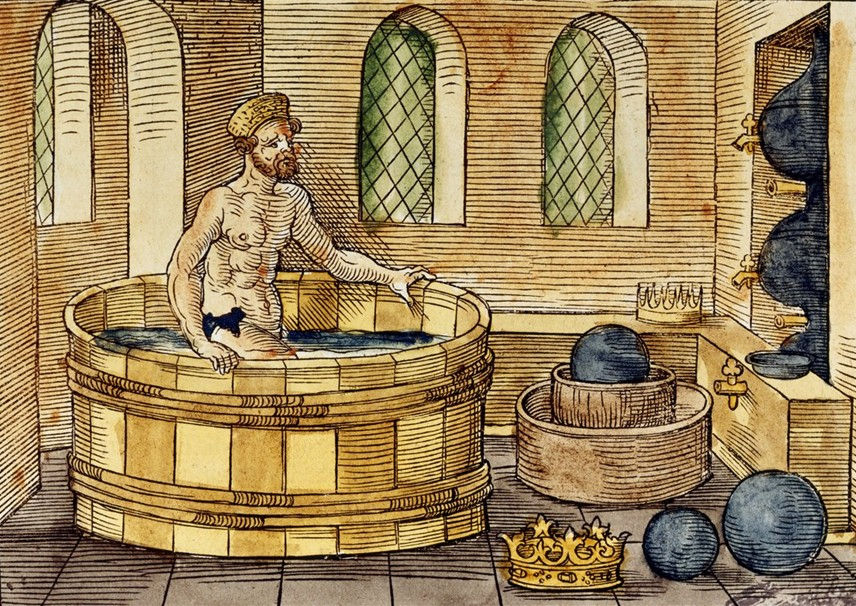The Eureka moment that made a splash in science: the story of Archimedes' Principle
- Physics Core

- Apr 26
- 3 min read
Updated: Jul 15
We find ourselves in ancient Greece, around 250 BC. King Hiero of Syracuse commissioned local goldsmiths to make a crown and got suspicious that the gold was mixed with silver. The formidable ruler vowed to catch the culprits and asked Archimedes, the famous mathematician and physicist, to help. Gold is nearly twice as dense as silver. Therefore, a gold crown would have a smaller volume than one mixed with silver, assuming they both had the same weight. Estimating the volume of a regular object posed no issue. But how could one determine the volume of the intricate crown without melting it down? That was the challenge Archimedes faced.

Legend has it that Archimedes discovered a solution while immersing himself in the bath (Fig. 2). Observing the water level rise, he realized that the displaced water must match the volume of his submerged body. Thus, by submerging the crown in water, he could calculate its volume by measuring the change in water level. The elegant simplicity of this solution made him forget his nudity and run to Hiero's palace, exclaiming "Eureka!" or "I've found it!" This naked dash became a historical testament to the immense joy a discovery can bring to a scientist.
Equipped with this innovative method for determining the volume of irregular objects, Archimedes carried out the following experiment. He balanced the crown with pure gold pieces to ensure equal weight. If the crown contained silver, it would be larger and displace more water. He then placed the gold pieces in the water container and marked the water level. Afterwards, he put the crown in the container and observed that the water rose above the mark. The goldsmiths were caught cheating; science triumphed over greed.
Tragically, Archimedes was killed during the Roman invasion. Syracuse is now part of the island of Sicily in Italy. His final words to his assailant were, "Please, don't disturb my papers!" The brightest mind of his time, he lived and died like a legend, devoted to science until his last breath. Some of his legacy was lost during the war. His surviving work, the treatise 'On Floating Bodies', led to further developments in fluid dynamics, culminating in the formulation of the Archimedes principle as we know it today: a body immersed in a fluid experiences a buoyant force equal to the weight of the fluid it displaces.
Today, by applying the buoyancy principle, we can significantly simplify the test, letting nature do the math. After balancing the crown with pure gold in the empty container (Fig. 3, left), we can fill it with water (Fig. 3, right). If the crown is pure, the scale will remain in balance. However, if the balance tips towards the gold, the crown has a larger volume, indicating the presence of silver.

Assume the crown is pure and has a volume of 4 cm³, implying the gold must also be 4 cm³. In the empty container, the buoyant force will be the weight of 4 cm³ of air, identical for both. In the filled container, the buoyant force will be the weight of 4 cm³ of water, again the same for both. The scale will stay balanced in any medium because the force pushing them up will remain equal due to the equality of their volume.
Now, let the crown be impure, with an additional volume of 1 cm³, highlighted in red in Fig. 3. When the scale is balanced in the empty container, it accounts for the additional upward force, equal to the weight of 1 cm³ of air. In the filled container, this extra force increases because 1 cm³ of water weighs more than 1 cm³ of air. The resulting increase in buoyancy will lift the crown, causing the scale to tip towards the gold.
We can reverse the test and balance the crown in water first, which will necessitate the removal of some gold from the right pan. Once the water is drained, the crown will outweigh the gold because the buoyant force that supported it in water decreases in the air. This test can be repeated in any medium and any sequence. The balance will be disrupted when transferring the scale from one medium to another, as different media exert varying buoyant forces.


Comments